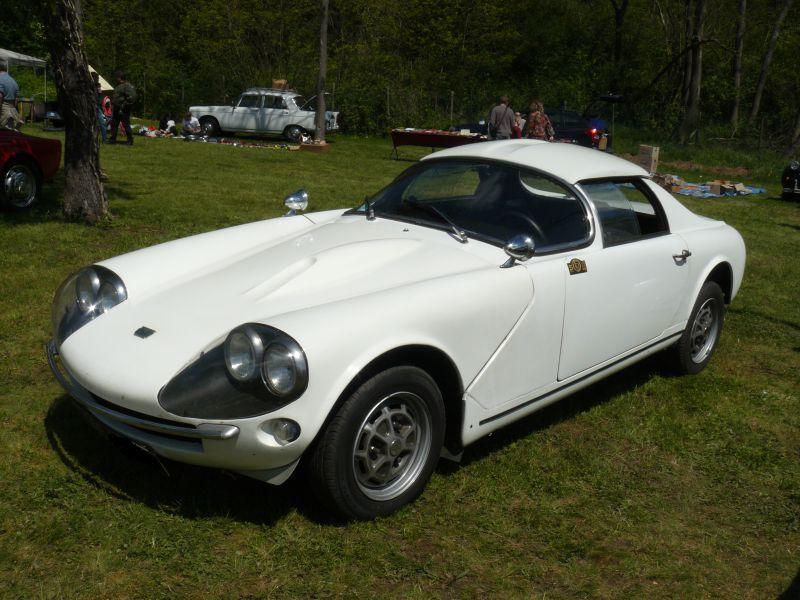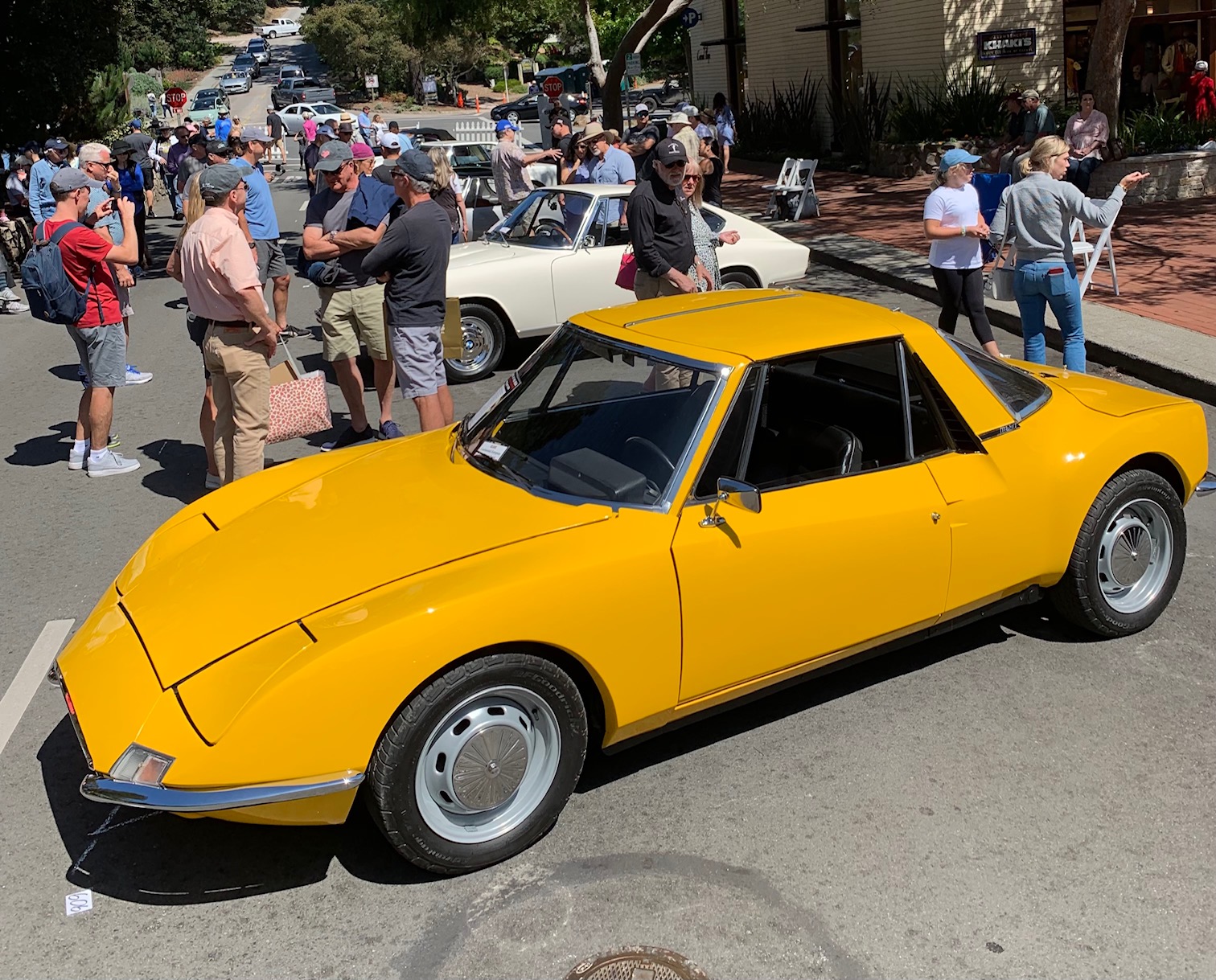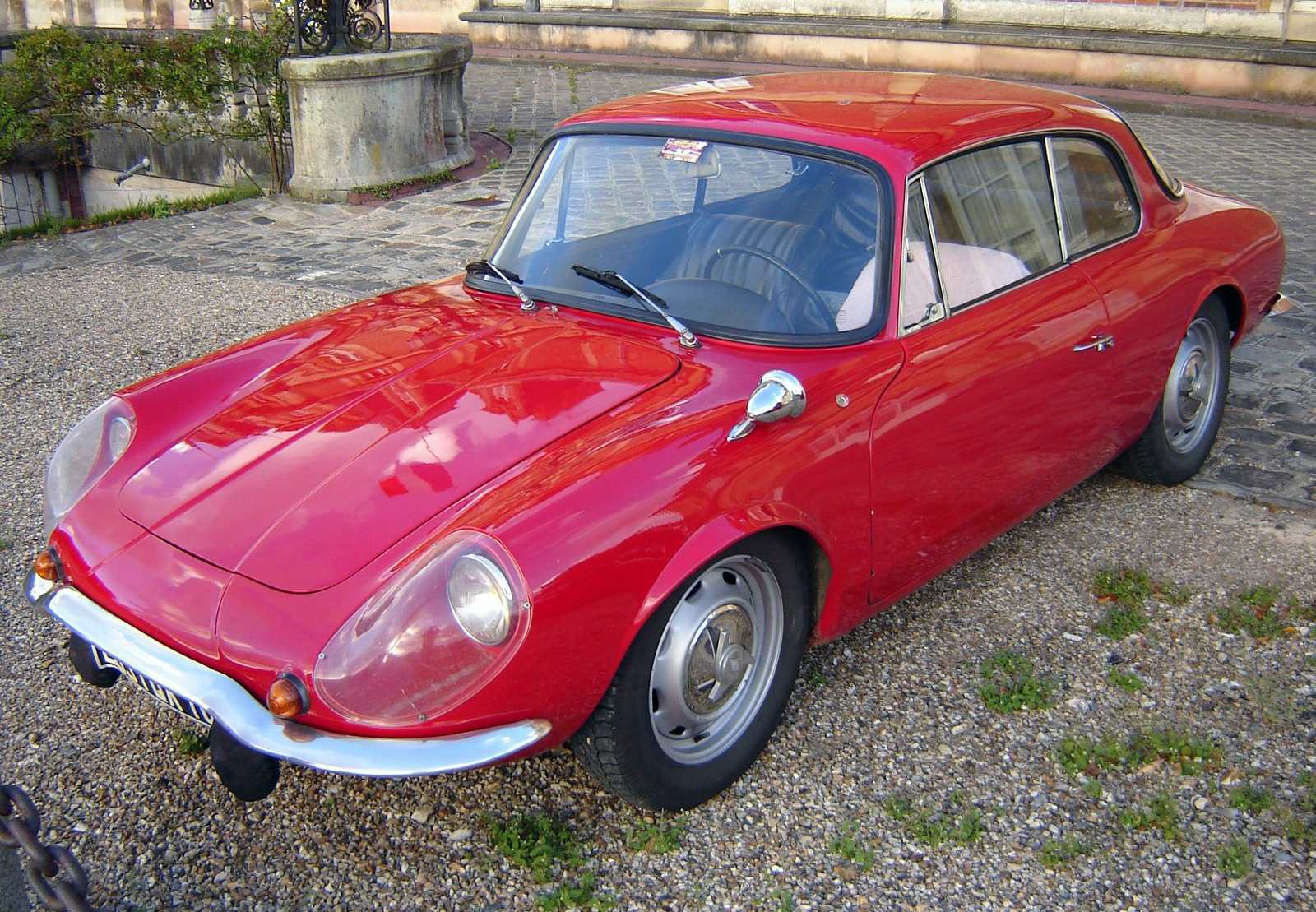|
Sovam Av
The SOciété des Véhicules André Morin (SOVAM) is a French company that specializes in mechanized handling equipment for airports. In the mid-to-late 1960s they also operated an automobile manufacturing division that enjoyed a modicum of success but that was never profitable. Early history The company was established by André Morin in 1930, and was an outgrowth of his father Robert Morin's existing car and carriage workshop business. Based in the commune of Parthenay in the department of Deux-Sèvres, Sovam specialized in the manufacture of "camions magasin", or mobile shop kiosks built on light truck platforms. In 1962 Morin spun this business off into the Etalmobil brand, and Sovam diversified into other lucrative niches, producing airport handling equipment and specialized light utility vehicles. In 1964 they introduced a “Véhicule Utilitaire de Livraison” (light delivery vehicle) or `VUL' which used a fibreglass truck or van body mounted on a shortened Renault 4 cha ... [...More Info...] [...Related Items...] OR: [Wikipedia] [Google] [Baidu] |
Parthenay
Parthenay () is an ancient fortified town and Communes of France, ''commune'' in the Deux-Sèvres Departments of France, department of the Nouvelle-Aquitaine Regions of France, region in western France. It is sited on a rocky spur that is surrounded on two sides by the Thouet, River Thouet, and is the Subprefectures in France, sub-prefecture of the Arrondissement of Parthenay, Parthenay Arrondissements of France, ''arrondissement''. It is situated some north of Niort, west of Poitiers, south-east of Nantes, and south-west of Paris. Each July, Parthenay hosts the ''Festival Ludique International de Parthenay'', otherwise known as the ''Festival de Jeux'' or ''FLIP'', in which the town's streets and squares are filled with games of many types. The shorter indoor ''FLIP d'hiver'' runs in November. History Legend has it that Parthenay was created with a wave of the fairy Melusine's wand. However the name of Parthenay first appears in written records at the beginning of t ... [...More Info...] [...Related Items...] OR: [Wikipedia] [Google] [Baidu] |
Arista (1956 Automobile)
The Arista was a French automobile with a fiberglass body, produced in Paris from 1952 to 1967. Background The firm had been founded in the late 1940s by Antonio Monge and Robert Rowe under the name Callista, but the two fell out over the future direction of the firm after its original project, a sporting model called the "Coupe des Alpes" first seen in prototype form at the 1950 Paris Motor Show, appeared likely to be severely undercut on price when Panhard themselves launched their Panhard Dyna Junior with a comparable level of performance at a far lower price than Callista could achieve with their elegant low volume cars. Monge resolved to return to his former occupation, preparing cars for motor sport events. Shortly after this setback Rowe, who had previously worked as an electrical engineer with the Fulmen business, but who also engaged in other trading activities, suddenly found himself financially ruined after he imported to France several hundred Romanian tractors that tu ... [...More Info...] [...Related Items...] OR: [Wikipedia] [Google] [Baidu] |
Defunct Motor Vehicle Manufacturers Of France
{{Disambiguation ...
Defunct (no longer in use or active) may refer to: * ''Defunct'' (video game), 2014 * Zombie process or defunct process, in Unix-like operating systems See also * * :Former entities * End-of-life product * Obsolescence Obsolescence is the state of being which occurs when an object, service, or practice is no longer maintained or required even though it may still be in good working order. It usually happens when something that is more efficient or less risky r ... [...More Info...] [...Related Items...] OR: [Wikipedia] [Google] [Baidu] |
Engineering Companies Of France
Engineering is the use of scientific principles to design and build machines, structures, and other items, including bridges, tunnels, roads, vehicles, and buildings. The discipline of engineering encompasses a broad range of more specialized fields of engineering, each with a more specific emphasis on particular areas of applied mathematics, applied science, and types of application. See glossary of engineering. The term ''engineering'' is derived from the Latin ''ingenium'', meaning "cleverness" and ''ingeniare'', meaning "to contrive, devise". Definition The American Engineers' Council for Professional Development (ECPD, the predecessor of ABET) has defined "engineering" as: The creative application of scientific principles to design or develop structures, machines, apparatus, or manufacturing processes, or works utilizing them singly or in combination; or to construct or operate the same with full cognizance of their design; or to forecast their behavior under specific ... [...More Info...] [...Related Items...] OR: [Wikipedia] [Google] [Baidu] |
Moving Walkway
A moving walkway, also known as an autowalk, moving pavement, moving sidewalk, people-mover, travolator, or travelator, is a slow-moving conveyor mechanism that transports people across a horizontal or inclined plane over a short to medium distance. Moving walkways can be used by standing or walking on them. They are often installed in pairs, one for each direction. History The first moving walkway debuted at the World's Columbian Exposition of 1893, in Chicago, Illinois, in the United States as ''The Great Wharf Moving Sidewalk'' and was designed by architect Joseph Lyman Silsbee. It had two different divisions: one where passengers were seated, and one where riders could stand or walk. It ran in a loop down the length of a lakefront pier to a casino. Six years later a moving walkway was also presented to the public at the 1900 Exposition Universelle in Paris as the '' Rue de l'Avenir''. The walkway consisted of three elevated platforms, the first was stationary, the second m ... [...More Info...] [...Related Items...] OR: [Wikipedia] [Google] [Baidu] |
Transmission (mechanics)
Propulsion transmission is the mode of transmitting and controlling propulsion power of a machine. The term ''transmission'' properly refers to the whole drivetrain, including clutch, gearbox, prop shaft (for rear-wheel drive vehicles), differential, and final drive shafts. In the United States the term is sometimes used in casual speech to refer more specifically to the gearbox alone, and detailed usage differs. The transmission reduces the higher engine speed to the slower wheel speed, increasing torque in the process. Transmissions are also used on pedal bicycles, fixed machines, and where different rotational speeds and torques are adapted. Often, a transmission has multiple gear ratios (or simply "gears") with the ability to switch between them as the speed varies. This switching may be done manually (by the operator) or automatically (by a control unit). Directional (forward and reverse) control may also be provided. Single-ratio transmissions also exist, which simply cha ... [...More Info...] [...Related Items...] OR: [Wikipedia] [Google] [Baidu] |
Poppet Valve
A poppet valve (also called mushroom valve) is a valve typically used to control the timing and quantity of gas or vapor flow into an engine. It consists of a hole or open-ended chamber, usually round or oval in cross-section, and a plug, usually a disk shape on the end of a shaft known as a valve stem. The working end of this plug, the valve face, is typically ground at a 45° bevel to seal against a corresponding valve seat ground into the rim of the chamber being sealed. The shaft travels through a valve guide to maintain its alignment. A pressure differential on either side of the valve can assist or impair its performance. In exhaust applications higher pressure against the valve helps to seal it, and in intake applications lower pressure helps open it. The poppet valve was invented in 1833 by American E.A.G. Young of the New Castle and Frenchtown Turnpike and Railroad Company, Newcastle and Frenchtown Railroad. Young had patented his idea, but the 1836 U.S. Patent Offic ... [...More Info...] [...Related Items...] OR: [Wikipedia] [Google] [Baidu] |
Boujan-sur-Libron
Boujan-sur-Libron (; oc, Bojan) is a commune in the Hérault department in southern France. Population See also *Communes of the Hérault department The following is a list of the 342 communes of the Hérault department of France. The communes cooperate in the following intercommunalities (as of 2020):Communes of Hérault {{Hérault-geo-stub ... [...More Info...] [...Related Items...] OR: [Wikipedia] [Google] [Baidu] |
Renault 16
The Renault 16 (R16) is a D-segment family hatchback produced by French automaker Renault between 1965 and 1980 in Le Havre, France. The Renault 16 was the first French winner of the European Car of the Year award. Market placement In the early 1960s Renault was building a series of small cars, like the hatchback Renault 4 and rear engine Renault Dauphine and aimed to replace its larger family car, the Renault Frégate model (1951–1960) which had managed a modest production total of 163,383 units. The R16 was a great success, with 1,845,959 R16s produced during a production run of 15 years. The car sold well in most of Europe, winning praise for its spacious and comfortable interior as well as the practicality offered by its effectively unique hatchback bodystyle. It was marketed in the United States, but was not successful and only a tiny number were sold. Design Under the skin, the layout of the R16 is similar to the Citroën Traction Avant – front-wheel drive, engine ... [...More Info...] [...Related Items...] OR: [Wikipedia] [Google] [Baidu] |
Matra 530
The Matra M530 is a sports car created and built by the French engineering group Matra. Development In 1965 Matra's CEO Jean-Luc Lagardère decided to develop a successor to the Matra Djet that was more appealing to the non-racing public - a ''voiture des copains'' (car for chums). The result was the Matra M530, the first "true" Matra sports car, the Djet having been a René Bonnet design. The car was named after Matra's R.530 missile, and was designed by former Simca designer Philippe Guédon. Like its predecessor, the M530 was built on a steel frame with polyester body and a mid-engine layout. To accommodate 2+2 seating, a mid-mounted engine and a reasonable boot, various engine options were considered. In the end, the running gear came from Ford in Germany, akin to the Ford Mustang I prototype the "high compression" 1699 cc Ford Taunus V4 engine and gearbox from the Taunus 15M TS were chosen and mounted in a transaxle layout. This combination was compact enough to fit betwee ... [...More Info...] [...Related Items...] OR: [Wikipedia] [Google] [Baidu] |
Alpine A110
The Alpine A110 is a sports car produced by French automobile manufacturer Alpine from 1963 to 1977. The car was styled as a " berlinette", which in the post-WWII era refers to a small enclosed two-door berline, better-known as a coupé. The Alpine A110 succeeded the earlier A108. The car was powered by a succession of Renault engines. A car also named Alpine A110 was introduced in 2017. History Launched in 1963, the A110, like previous road-going Alpines, used many Renault parts, including engines. While its predecessor the A108 was designed around Dauphine components, the A110 was updated to use R8 parts. Unlike the A108, which was available first as a cabriolet and only later as a coupé, the A110 was available first as a berlinette and then as a cabriolet. The most obvious external departure from the A108 coupé was a restyling of the rear bodywork. Done to accommodate the A110's larger engine, this change gave the car a more aggressive look. Like the A108, the A110 ... [...More Info...] [...Related Items...] OR: [Wikipedia] [Google] [Baidu] |
Renault Cléon-Fonte Engine
The Cléon-Fonte engine, also known as the Sierra engine or under the code "C-engine" or "C-Type" (C for Cléon, where it was built, ''fonte'' being French for cast iron), is a family of four-cylinder, Straight engine, inline automobile internal combustion engine, engines manufactured continuously by Renault and its subsidiary Automobile Dacia, Dacia from 1962 to 2004. For about three decades it was a mainstay in Renault's subcompact, compact models, before being gradually replaced by the Renault Energy engine, E-type engine from the late 1980s onward. The C-type is an overhead valve, water-cooled design, with a 5-bearing crankshaft, a chain driven, side-positioned camshaft operating the valves via pushrods and Rocker arm, rockers, and an aluminum cylinder head. History When production started in 1962, this (then) modern engine was initially called the "Sierra"; it was soon renamed the "Cléon-Fonte", taking its name from the ultra-modern Renault factory where it was first manuf ... [...More Info...] [...Related Items...] OR: [Wikipedia] [Google] [Baidu] |








